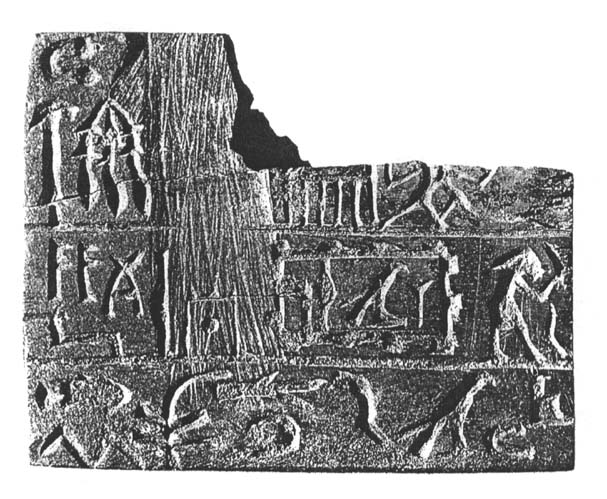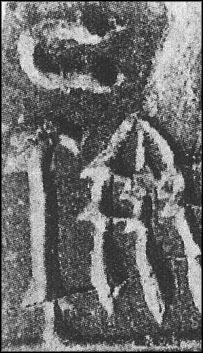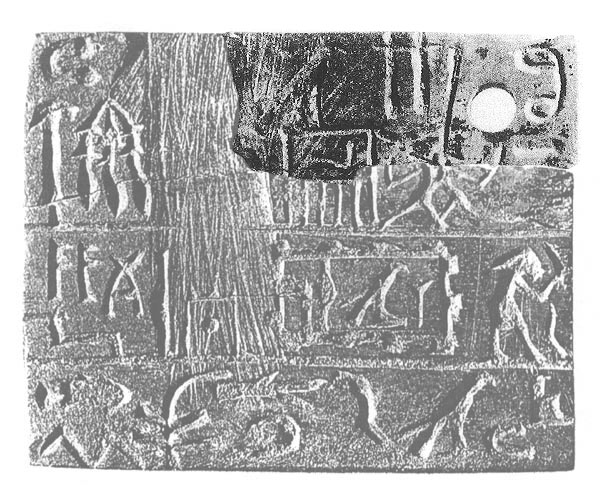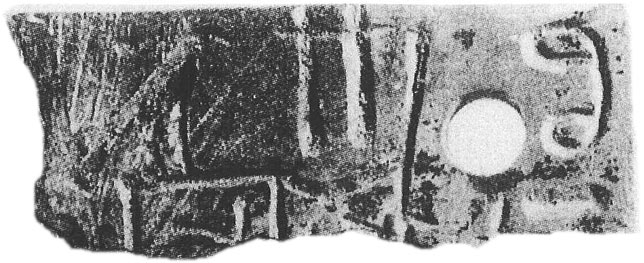This label appears to belong early in Horus Djet's (short) reign. It retains in fact the horizontal registers arrangement as in Aha and Djer labels. Consequently I assume labels Djet 1-2 of this corpus to be later than the present one.
Mentioned events cannot be directly compared with those reported on the Annals because no year-case of the reign of Djet [0] has survived on the preserved Annals fragments.
Small inscribed etiquettes are fundamental sources for the progress of our comprehension of the archaic Egyptian state. Informations about politics (military raids), religion (royal visits of temples, various feasts and specifical rituals, fashioning of divine images, constructions of shrines, temples or parts thereof), economy and trade (names of high functionaries, institutions, workshops, levies, Egyptian or imported commodities such as wine, oils, fragrances, timber), ancient sites (place names), early iconographic canons, writing system and language are all concealed in each one of these precious sources.
The first 'event' documented on this label is an important one, for it seems to prolong the history of the Egyptian military raids in Lower Nubia (Ta-Sety) up to the reign of Horus Djet [1].
INTERPRETATION, TRANSLATION AND COMMENTARY
- Register 1
(A) A new fragment of the label (the central-upper right portion of the first register) from the debris north of Den's tomb T adds important information for the reading of the object. Additionally another complete sample of this label has been recently found (Ab K2602).
The st-bow and the tA sign are clearly visible on the upper right corner of the reconstructed label; beyond the label's hole two human figures are represented fighting with knives in their hand [2]. Further on the left, the serekh frames the right half of the label's first register: the name within it is that of 'Horus Djet' [3]. An arm with the hand holding a long stick protrudes from the upper right corner of the serekh, in a classic gesture of sheer violence against the foe, a symbolism which had already a long iconographical history before this early First Dynasty occurrence [4].
The 'animated serekh' threatens the Ta-Setj(w) [5] with a stick blow (the weapon is drawn just above the two contenders and it seems directed towards the Ta-Sety toponym / ethnonym).
Two cross-like hieroglyphs above the duellists are probably referred to the latter ones and almost certainly represent nD signs [6].
There are alternative interpretations of this combination: if it was a verb, nDnD, it would express and clarify the beating action performed by the serekh hand (hence by the king himself) and the reading would be "the king Djet annihilates (on) the struggling Nubians" [7]. However such a pleonastic specification (as it was a phoneme plus determinative) would seem unnecessary, for the thrashing action is already clear in its pictographic essence and early writing is always as short and straight as possible. Verbs of this category are absent in the archaic writing (i.e. before Dyn. 4-5) and the violent meaning I have proposed, on the basis of one of the verbs nD, is unknown, thus highly improbable (cf. n. 7).
If the two signs were meant to indicate a substantive, the dual nDwy, it ought to be related to the object of the king's smiting ('the two contenders/wrestlers', or 'the two servants') [8]. This would not be a useless addition (for it would further qualify the status of the Ta-Setyw). The latter one seems to me the best of the possible interpretations.
Mr. Lieffering, who also suggested me the reading nDwy, notes that it could be rendered as 'the two protectors' (from 'counsel/schuetzen' in:
J. Kahl.FAW, vol. III, 459) which, in his opinion, would be related to the king's name (as in Horus Adjib's Nebwy title) rather than to the fighters. But there are no known parallels for this particular compound.
Additional signs:
In a duplicate of this label (for which information I am grateful to Mr. B. Lieffering; cf. below for the reference) an arm, drawn out of the Horus back, holds a pear-headed mace. On the present label the mace-head circle is visible at the left of the Horus' head, while mace and hand are more faint.
On the right end, underneath the tA hieroglyph, (in the main fragment of the label) there seems to be a horizontal sign (?) I cannot identify at present (perhaps Ssp or the S -pool?), and further down, what looks like a strange prolongation of the right Nubian's leg.
(B) The T (tch/tj) hieroglyph is strange in this position: it might be the first phonetical sign of the Jmy-wt/Iat resembling pole/scepter below it, or rather the last part of a short sentence or name which begins in the lacuna. In this obliterated space after the serekh, a shrine could have been represented or a private name (cf. Sekhemkasedj name on Djet 1-2 labels) [9].
It is important that the duplicate of this label (Ab K2602, also from debris N of Den's tomb: mentioned by Dreyer, in: MDAIK 59, 2003, 94) has just the same obliteration of the name originally written after the serekh: this systematic effacement would indicate that the official in object must have "fallen out of grace at court" (using the words of Mr. B. Lieffering whom I must thank for our exchange of opinions and informations) [10].
Ms(t)-Imyut (IAt ?)
The publisher (MDAIK 54, 163) translates "Geburt des Imiut": the sign is very different from that of the Imy-wt fetish representations of Ist dyn. date but as we have said about the twin signs in Djet 1-2 labels, a very differently looking symbol for the same object cannot be ruled out [11].
In my opinion the best possibility is that the sign refers to the milk goddess jat/jatet/jamet, also 'celebrated' in Djer's 6th year (Palermo Stone, recto, II,8; thanks to Mr. B. Lieffering for pointing me out this possibility which I had initially overlooked) [12].
- Register 2
(C) A priestly figure, wearing a kilt and a cap with hanging protuberance, has a knife held with blade upwards in his hand; at his feet there is a stroke-like sign [13]. Dreyer thinks this stroke on the Djet label to be the Tehenw throwing-stick, and the armed man as representing a raid (thus against Libyans). In my opinion this interpretation is erroneous. I also doubt, but to a less degree, that this is meant as an event of its own: the pictogram might as well be linked to the fortress which follows in the same register inscription. The vertical stroke could be the numeral Dba (10.000) or simply 1 (first ?). A possible connection of this man with sacrifice offerings could be provided by Kaplony, IAF I, 636, which would link the action this man is performing with the small building (Hwt-Hedj, Hwt-Shena, but not Hwt-Seqer) represented on this label beyond the fortress (cf. below).
If the analyzed compound is not connected with the buildings mentioned after it, the man with knife should have a full auto-conclusive meaning, hence, like in Dreyer's interpretation, the logical object of the sentence would be the vertical bent stroke in front of the priestly (?) figure.
(D) The fortress is named "House of the ? of Horus' command", Hwt ?-Hrw-WD (the Hwt sign = temple/palace, is the small rectangle in the left corner of the fortress). The sign before the falcon looks like the one in Kaplony, IAF III, fig. 138 sealing (a simple pole with V top, which recalls the characteristic V-shaped flint Pesesh-kef blades; note: this is different from the mentioned crescent topped pole ibid., fig. 137). It shouldn't be Gardiner M13 (WAD, wadj). However I think this building could be identical with Horus Djet (seal impressions) known domain WD-Hrw.
After this building there seems to be a palace with a pear-headed mace within it (aH-HD, Hwt HD or HD-Wrw ?) and three khekher atop of its roof. There is also a good possibility it is a graphic variant of the Hwt Shena [14].
There are few doubts that this palace is a structure (or a department) within the Wdj-Hrw domain which precedes it in the inscription.
The ritual which is performed by the knife-handling priest's, should thus be meant as a verb/action referred to the aH-HD (= Per-Hedj treasury) or aH-Sna of the '?-Wdj-Hrw' temple (or royal domain). Or the latter might be understood as the place where the ceremony was given.
On the other hand, the two sets of signs might be independent, and part of two different events: in this circumstance the two building would have no conclusive sense by their own and I would think that they represent the site/locus where the following (E) event took place (cf. note 15).
(E) On the left, Qd(.t) mrj nTrwy (building the "Beloved of the two gods"). The determinative, a two steps (st ?) ramp-sign, is added at the end of the name to clarify the type of building in object [15].
- Register 3
(F) Setjet-Hor wHmw (name/type of oil)[16] /// [quantity] 100 "branches"[17] /// jnw-Sma (as Upper Egyptian tribute) [18]. --- --- --- NOTES --- --- --- [0] This king's reign was likely engraved at the extreme right of line 3 in the original Memphite annals slab (cf. Helck, Thinitenzeit, 1987, 125).
[1] There are not later hints at any relationship with Nubia before the late Second Dynasty. We know that Buhen might have been founded in this period, the same as the often mentioned 'raid' by Khasekhemwy against Ta-Sety (after Cairo JdE 33895).
However at least one scholar (A. Jimenez-Serrano, in: BAEDE 12, 2002) has noticed that this sentence could have been a purely ritual statement, just as the one reproduced below it (Tbt Axr r xAswt, excellent sandal against the foreign lands); this is supported by the lack of informations (both textual and archaeological) about Lower Nubia in the period between mid First Dynasty and early Fourth/Fifth Dynasty (OK and later royal propaganda inscriptions have often been often to be mere copies of those of the predecessors, not real 'historical' accounts).
For Ta-stj in early inscriptions cf. Abydos K1103b1 knife-handle from tomb U-127: Dreyer, Motive und Datierung..., in: Ziegler (ed.), L' Art de l'Ancien Empire ègyptien, 1999, 206, fig. 10b; small tags in Dreyer, Umm el-Qaab I, 1998, nr. 45-49 (cfr. Kahl, CdE 78, 2003, 125, fig. 7); Siali seal; Djebel Sheikh Suleiman graffito and Hor-Aha label 5 and label 12.
[2] Similar duels are known on a few Late Predynastic and Early Dynastic objects: the Gebel el-Arak knife handle (Louvre E11517; cf. U. Sievertsen, Baghdader Mitteilungen 23, 1992, 1-75), the Abydos U cemetery tags (cf. Dreyer, Umm el-Qaab I, 1998, 118, nr. 44 and p. 134, nr. X183; these should represent the same place-name as on the Tehenu palette, recto, 3rd from the right). ... ... ...
[3] This king's name had been already recognized by G. Dreyer when he published the main fragment in 1998, by the presence of the tip of the serpent's tail in the lower left corner of the name-compartment of the serekh (MDAIK 54, 1998, 163).
About the reading of the royal name as Djet, this is few more than a convention, nor is it the only one generally accepted (Wadj, Wadji, Zet, Serpent, Edjo, Wenewty; cf. E. Drioton, J. Vandier, L'Egypte, 1962, 638; Garnot, MDAIK 16, 1958; Kaplony, Orientalia Suecana 7, 1958, 64-66; W. Helck, Wadj, in: LÄ VI, 1126-1127; T. Wilkinson, Early Dynastic Egypt, 1999, 63).
[4] For Naqada I-II examples of this scene of enemies' subjugation cf. C. Köhler, in: MDAIK 54, 1998, 111f., pl. 6d (Naqada Ic vase from tomb U-239 <4a>) and the Hierakonpolis decorated tomb 100 (see bibliography in the linked page).
In later iconography the smiting scene is shown either performed by the king himself, or by the symbols of kingship (royal name, Horus falcon, animated standards) <4b>.
For Naqada III(A-C) occurrences of the motif cf. Narmer palette, Narmer ivory cylinder from Hierakonpolis (Ashmolean Mus. Oxford, E3915), Narmer year-label (Dreyer, MDAIK 54, 1998, 139), Hierakonpolis ivory cylinders (J.E. Quibell, Hierakonpolis pt. I, pl. 15, nr. 1, 2, 4, 7; P. Kaplony IAF III, fig. 2A-C = lower right in this image), Djer stone plaque from Saqqara mastaba 3471 (Emery, Great Tombs I, 60, fig. 31), Den Mac Gregor label.
In the Third Dynasty we have the Wadi Maghara reliefs of Djoser, Sekhemkhet and Sanakht (British Museum EA 691).
In general cf. E.S. Hall, The Pharaoh smites his enemies. A Comparative study, MÄS 44, 1986; E.C. Köhler, History or ideology?... in: E. van den Brink - T. Levy (eds.), Egypt and the Levant, 2002, (Chapter 31) 499-513.
[4a] It should be said that at least some scholars, namely Y. Garfinkel, in: CAJ 11/2, 2001, 241-254, and J.J. Castillos (in a internet review of T.A.H. Wilkinson's book 'Genesis of the Pharaohs', 2003, 79, fig. 21) have expressed doubts about the interpretation of this painted scene as one of violence against the enemies: in their opinion the C-ware vessel decoration would instead represent some phases of a pacific dance ceremony).
[4b] This motif parallels the scenes of 'binding the enemies' (on behalf of the king/chief himself, but also of gods, standards, human captors): some examples of this further motif are the London UC 15339 and the Brussels MRAH E3002 late Naqada I C-ware vessels, the quoted tomb 100 painting (the same three captive subject to the chief's mace-blow are also tied by a rope), the graffito Djebel Tjauty 1, the boss side of the Oxford knife handle from Hierakonpolis (E4975, cf. note 12), the Metropolitan Museum knife handle (boss side, upper left), the Bull palette, the Royal Macehead (UC14898) from Hierakonpolis, the Narmer palette, the ivory mace-head from Hierakonpolis (J.E. Quibell, Hierakonpolis pt. I, pl. 12.4) and some early First Dynasty ivories from Abydos cemetery B (Petrie, RT II, pl. 4.20).
[5] The "wrestlers" are likely to represent fighting Nubians (rather than an Egyptian vs. a Nubian): therefore the situation would recall the later C-group polities' battles (Yam vs. Temeh) which were described in the third journey of Harkhuf (Assuan, reign of Merenra) occurring in the western desert/oases of Lower (and northern Upper-) Nubia.
[6] In Gardiner's hieroglyphic signs list this is Aa27. For early use of this sign cf. Den label 19; Kaplony, IAF III, 414 (= sealing UC11067); also see the object painted on the verso of the Naqada mastaba label Aha 1, which has been possibly identified as a top toy. It seems we can fairly discard the hieroglyph from being a vertical O29 (aA, great) hieroglyph.
[7] There is a verb nD (WB II, 369, 11ff.) that means 'crush', 'smash' (but in the sense of milling, powdering, grinding small substances) which could explain and fit the serekh gesture; the verbs formed by biliteral signs duplications can hint at active movement, an amplification of the action indicated by the simple biliteral verb (cf. Shipwrecked Sailor, 59: xt Hr gmgm, tA Hr mnmn); but nDnD meaning (cf. WB II, 382, take counsel, question) derives from the nD-root which means '(to) question'.
[8] Cf. previous note and WB II, 369ff.; Faulkner, Concise Dictionary, 143f.; Wallis Budge, EHD, vol. 1, 409ff.
[9] There is a palace named on a sealing of Djet/Merneith's period (Kaplony, IAF III, 241) which is written as a rectangular building with a ram standing on it and the name within the building is jT, but it's a very remote possibility (nearly a mere example here) that this could be the meaning of this T (and this doesn't explain its intentional erasure).
Also the verb jT (Kahl, FAW, vol. 1, 65; WB I, 149, 3ff.) could be meant, but that's just another equally unlikely option.
[10] Partial erasures of labels are very rare (compared to inscriptions on the stone vessels): in Djet's reign we have label Djet 3 which has the serpent name of the king erased in the apposite serekh space. There are more examples of labels re-used with no alteration (i.e. found -not intrusive- in tombs of later kings/official than the reign to which their inscriptions refer).
[11] For the Imiut cf. U. Köhler 1975; id., in: LÄ III, 149-150; T.J. Logan, in: JARCE 27, 1990, 61-9.
Imy-wt fetishes are known to have been fashioned during the first half of the First Dynasty: Aha's reign (labels: Aha 2, 3, 4; decorated ivory in Petrie, RT II, pl. 4, 16-17), Djer's reign (Annals: Cairo 1, line 2,7) and Den (Annals: Cairo 5 = De Cenival, BSFE 44, 1965, 13ff.).
They are also represented on Djoser's boundary stelae (in front of the serekh) from the Saqqara Step Pyramid complex.
[12] For this goddess cf. Kaplony, Klein Beitrage zu den Inschriften der Ägyptischen Frühzeit, 1966, 80-82 (and related notes); J. Kahl, FAW vol. 1, 9; cf. also WB I, 27,1; W. Helck, LÄ III, 114; Pyramid Texts: utt.146/§89b, utt. 211/§131d.
I suggest some possible parallels for this sign at the left end of line 1: cf., H. Whitehouse, A Decorated Knife Handle from the 'Main Deposit' at Hierakonpolis, MDAIK 58, 2002, 425-446
(p. 436, fig. 1, pl. 46: the tall sign in front of the Per-Wr shrine on the flat side of the knife handle).
Mrs. Whitehouse reconstructed the vertical sign on the Oxford handle as possibly a PsS-Kf (indeed as the PsS-kf resembling sign inscribed on some sealings with the Per-wr and lioness motif: cf. Kaplony, IAF III, fig. 137).
Considering that a royal name is more likely to appear in front of the king's face/crown, the emblem between the back of the king and the Pr-Wr shrine should be related to the latter. Yet the location/god is perhaps indicated by the Elephant on snakes represented below the shrine, so the vertical emblem would have a different purpose, being perhaps a cult pole or weapon <12a> planted in front of the temple (I don't believe that it may be the early hieroglyph for Imnt, "west" or Iabt, "east", for the Hunters palette already clearly shows the sign in their classic shapes). The whole sign must be therefore a composite emblem or fetish (as the Imj-wt, Neith, Seshat or Netjer signs) topped by a flint blade or crescent (probably jatet goddess' wAs-scepter).
Another parallel I've found might be the (twin) crescent signs atop an 'animated' standard on the MMA knife-handle boss side upper left corner (for this artifact, Metropolitan Museum of Arts 26.241.1, cf. B. Williams - T.J. Logan, JNES 46, 1987, 245ff.).
[12a] The object on the Oxford knife handle (but certainly not that on our label) might as well represent a pear-headed mace with decorated handle: about the ceremonial use of free standing maces see the relief on the Oxford E4714 carved bone cylinder from Hierakonpolis, also published by H. Whitehouse in: R. Friedman - B. Adams (eds.), The Followers of Horus, 1992, 77-82 (see upper line second image from the right: here).
[13] Cf. the similar figure carrying a basket in the second register of Aha label 3, left: in this latter case the signs at the man's feet should be read as a '4th time/occasion...' <13a>.
Other parallels for the figure on the Djet 16 label (Aha 1, second register; Den 1, upper left) seem to express oil-pressing.
In the possible instances of more violent actions' accounts (military raids or victories, human sacrifice or bloodletting) the figure of the subject is mostly present on the label as a pictogram-like determinative: cf. Aha 2, Aha 5, Djer 2, Den 1, Den 2, Den 29, Den 31 (for the possible sacrifice scene on Aha 2 and Djer 2 labels cf. M. Baud - M. Etienne, in: Archéo-Nil 10, 2000, 55ff.; B. Menu, in: Archéo-Nil 11, 2001, 165ff.; for the interpretation of Den warfare activities and the comparison with annals year-names cf. G. Godron, Etudes sur l'Horus Den..., 1990).
[13a] I wish to shortly add here my own new interpretation of the 'Sem-priest' figure on Aha label 3: the two signs above the basket he carries have always been read as "sm". But similar human figures are never identified by titles/names in the labels corpus and, once again, such a specification would seem unnecessary. It is more probable that the hieroglyph read as a 's' monoliteral (cf. Kahl, Das Synstem..., 1994, 699, Quelle 284a) represent instead the djam-sceptre (ibid., 705; Gardiner S40, although written in the opposite direction). This and the following m-owl sign give the common graphic of Dam (fine gold, WB V, 237-238). Thus it is this precious material that the priest (?) is carrying in the basket (or is it a electrum dish/bowl?). Therefore the first event in the Aha label second register should represent the 4th time of reception of djam-gold: according to the 5th Dynasty Annals this metal was brought from Punt at the end of the reign of Sahura (Palermo stone, verso, line 4,1; = Urk. I, 246, 4).
[14] Kaplony, IAF I, 636; Quibell, Archaic Mastabas, 1923, pl. 9 (cf. Urk. I, 171-172) from Horus Djer's reign Saqqara mastaba 2185: the official named on the sealing is Sekhemka-Sedj (Kaplony, IAF I, 634-636), who started his career in Djer's reign to end it up early in Den's one.
[15] Perhaps this could belong to the same class of building as the later Horus Adjib's stepped Ha-Za-Hor (?) or to the -Ntrw enclosures of dyn. 1 and 3 (Smer-Ntrw, Swt-Neterw, Nmtwt-Neterw, Qbh-Ntrw). Cf. P. Kaplony, ZAS 88, 1962, 5-16.
Or it could be rather a podium or another feature within one of the two aforementioned structures. See in particular Djer 1 label (second reg.) for a similar "step" included in the Semer-Netjerw (?).
[16] The sign after the bird is a ox leg (wHm) as can be discerned for comparison with the second label; sTt-Hr wHmw = Setjet Hor re-pressed oil (repeated-press, reused ?); cf. Helck, Thinitenzeit, 1987, 171 for wHmw (repeated; this oil type must be of worse quality than HAt oils). The same oil processing is indicated on Djet 2 label.
[17] A measure of oil-quantity [WB III, 339, 9 (NK wine measure), 341, 12 (MK length measure equivalent to 100 cubits); Vikentiev, ASAE 56, 1959, 26, n.2; Helck, Thinitenzeit, 1987, 172)
[18] Note that the other similar label has the same oil type and quantity indication but the levy origin is instead different from that on Djet 16: it is equal to the one inscribed on Djet 1 label (hieroglyph in the lower left corner. The sign in the palace has been considered a table with two vases on it by Vikentiev; it recalls to me the throne sign in Qaa's serekhs: Petrie, Royal Tombs I, pl. 8,7; Z. Saad, The Royal Excavations at Helwan, CASAE 14, 1951, 29-30, fig. 11, pl. 29a; id., The Excavations at Helwan, 1969, pl. 92; P. Lacau - J.P. Lauer, PyrDeg IV, nr. 42-41; J. Baines, BSFE 118, 1990, 5ff., note 34, fig. 7).
Francesco Raffaele, Aug. 3-6, 2004 |



